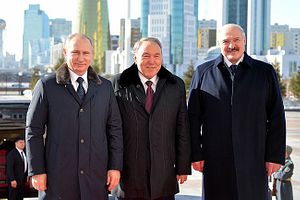The Eurasian Economic Union and the New Silk Road are two major foreign policy projects which Russia and China, respectively, have been pursuing since the early 2010s. The initiatives are the pet projects of the two states’ leaders.
Vladimir Putin proposed the Eurasian integration in October 2011, while running for his third presidential term. In an article published in Izvestia, Putin sketched out his ambitious vision of a Russian-led political-economic bloc in the post-Soviet space. Russia convinced Belarus and Kazakhstan to sign up to the project the following month but it took another three years to sign the treaty establishing the Eurasian Economic Union. 2015 marked the official inauguration of the union, which was almost immediately enlarged to include Armenia.
Xi Jinping put forward the idea of renewing the Silk Road two years after Putin’s initial declaration of Eurasian integration. During a visit to Kazakhstan in September 2013, the Chinese leader vowed to create a “Silk Road Economic Belt” as the first step in the process of connecting China to Europe via Central Asia. Several weeks later, during his trip to Indonesia, Xi presented a parallel initiative, the 21st Century Maritime Silk Road. The idea of reviving the ancient Silk Road quickly became popular in the Chinese media and expert circles. “One Belt, One Road” became a popular slogan describing the project.
Taken at face value, both the Eurasian Union and the New Silk Road are geared towards economics. Their implementation will, however, have a significant and multifaceted political impact. As the two projects intersect first and foremost in Central Asia, commentators started pointing to an inevitable clash between Moscow and Beijing in this region. A closer look, however, suggests quite the opposite. Since Russia and China build their influence in third countries in very different ways, it allows them to avoid competition and reconcile their respective initiatives.
The way Moscow and Beijing launched their projects provides the first illustration of how different these initiatives are. Russia began very ambitiously, with declarations for an integrational project that would compare to the European Union. What took the EU four decades – the creation of the single market – the Russian-led organization was supposed to achieve in four years. From the very beginning, Russia saw the ultimate outcome: a fully-fledged integrational organization. China, in turn, concentrated on clearly specified economic undertakings, such as the construction of pipelines, railways and railroads. Xi Jinping announced the concept of the New Silk Road only after he could be certain that a substantial part of the work on the ground had been done. The “One Belt, One Road” concept does not have any specific endpoint. China may continue to implement the New Silk Road concept for decades to come, but it can also announce its success in a few years.
Fundamental Difference
There is a fundamental difference in the goals that push Russia and China to pursue grandiose projects. Moscow frames its project in terms of an exclusionary sphere of influence, which would confirm Russia’s status as a global great power. It is less interested in genuine economic integration than in the acknowledgement of its privileged status in the post-Soviet space by what it perceives as its peers – the West and China. As long as Moscow can gain prestige and keep up the appearance of great-power posturing, the nuances of the implementation process do not matter much. China’s aims related to the New Silk Road are at the opposite end of the logical spectrum. Beijing is first and foremost interested in continuing its economic expansion abroad. The ideas of renewing the Silk Road were framed in a non-exclusionary way. The concept remains open for all possible participants, from Asia through Africa to Europe. China makes no pretenses towards having a sphere of influence – Chinese scholars have even been reminded by officials not to compare the New Silk Road to the Marshall Plan, as the latter allegedly demonstrates “hegemonic features.”
Russia focuses on the form of its influence – Moscow insisted on the establishment of a legal foundation for the integration process and its institutionalization. China cares much more about the substance. The New Silk Road is therefore better understood as an umbrella for what remains bilateral economic engagement. These differences help explain why Russia and China can be expected to reconcile their respective interests in Central Asia.
Marcin Kaczmarski is an assistant professor at the Institute of International Relations, University of Warsaw and the head of the China-EU Programme at the Centre for Eastern Studies (OSW).

































